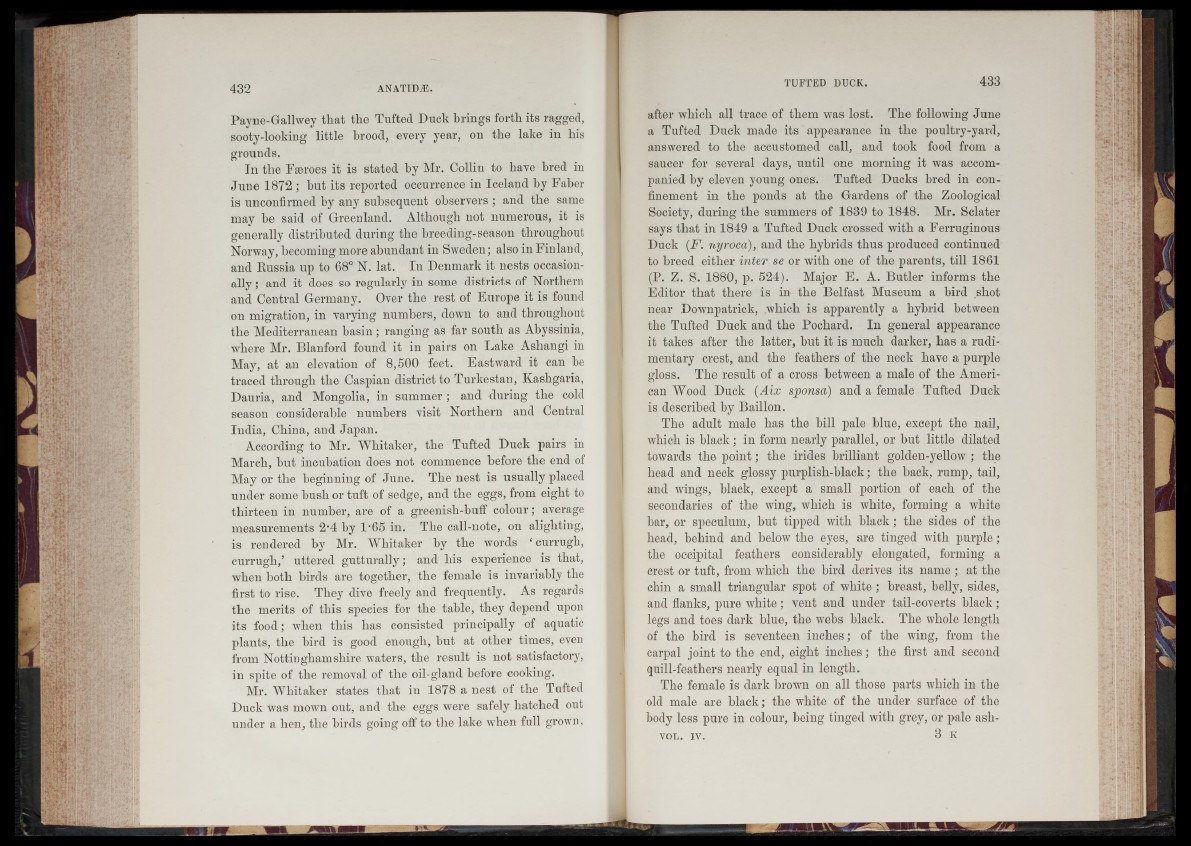
432 ANATIDiE.
Payne-Gallwey that the Tufted Duck brings forth its ragged,
sooty-looking little brood, every year, on the lake in his
grounds.
In the Faroes it is stated by Mr. Collin to have bred in
June 1872 ; but its reported occurrence in Iceland by Faber
is unconfirmed by any subsequent observers ; and the same
may be said of Greenland. Although not numerous, it is
generally distributed during the breeding-season throughout
Norway, becoming more abundant in Sweden; also in Finland,
and Russia up to 68° N. lat. In Denmark it nests occasionally
; and it does so regularly in some districts of Northern
and Central Germany. Over the rest of Europe it is found
on migration, in varying numbers, down to and throughout
the Mediterranean basin; ranging as far south as Abyssinia,
where Mr. Blanford found it in pairs on Lake Asliangi in
May, at an elevation of 8,500 feet. Eastward it can be
traced through the Caspian district to Turkestan, Kasligaria,
Dauria, and Mongolia, in summer; and during the cold
season considerable numbers visit Northern and Central
India, China, and Japan.
According to Mr. Whitaker, the Tufted Duck pairs in
March, but incubation does not commence before the end of
May or the beginning of June. The nest is usually placed
under some bush or tuft of sedge, and the eggs, from eight to
thirteen in number, are of a greenish-buff colour; average
measurements 2‘4 by 1*65 in. The call-note, on alighting,
is rendered by Mr. Whitaker by the words ‘ currugh,
currugh,’ uttered gutturally; and his experience is that,
when both birds are together, the female is invariably the
first to rise. They dive freely and frequently. As regards
the merits of this species for the table, they depend upon
its food; when this has consisted principally of aquatic
plants, the bird is good enough, but at other times, even
from Nottinghamshire waters, the result is not satisfactory,
in spite of the removal of the oil-gland before cooking.
Mr. Whitaker states that in 1878 a nest of the Tufted
Duck was mown out, and the eggs were safely hatched out
under a hen, the birds going off to the lake when full grown,
TUFTED DUCK. 433
after which all trace of them was lost. The following June
a Tufted Duck made its appearance in the poultry-yard,
answered to the accustomed call, and took food from a
saucer for several days, until one morning it was accompanied
by eleven young ones. Tufted Ducks bred in confinement
in the ponds at the Gardens of the Zoological
Society, during the summers of 1839 to 1848. Mr. Sclater
says that in 1849 a Tufted Duck crossed with a Ferruginous
Duck (F. nyroca), and the hybrids thus produced continued
to breed either inter se or with one of the parents, till 1861
(P. Z. S. 1880, p. 524). Major E. A. Butler informs the
Editor that there is in the Belfast Museum a bird shot
near Downpatrick, which is apparently a hybrid between
the Tufted Duck and the Pochard. In general appearance
it takes after the latter, but it is much darker, has a rudimentary
crest, and the feathers of the neck have a purple
gloss. The result of a cross between a male of the American
Wood Duck (Aix sponsa) and a female Tufted Duck
is described by Baillon.
The adult male has the bill pale blue, except the nail,
which is black; in form nearly parallel, or but little dilated
towards the point; the irides brilliant golden-yellow ; the
head and neck glossy purplish-black; the back, rump, tail,
and wings, black, except a small portion of each of the
secondaries of the wing, which is white, forming a white
bar, or speculum, but tipped with black ; the sides of the
head, behind and below the eyes, are tinged with purple ;
the occipital feathers considerably elongated, forming a
crest or tuft, from which the bird derives its name ; at the
chin a small triangular spot of white ; breast, belly, sides,
and flanks, pure white; vent and under tail-coverts black ;
legs and toes dark blue, the webs black. The whole length
of the bird is seventeen inches; of the wing, from the
carpal joint to the end, eight inches ; the first and second
quill-featliers nearly equal in length.
The female is dark brown on all those parts which in the
old male are black; the white of the under surface of the
body less pure in colour, being tinged with grey, or pale ash-
VOL. IV. 3 K